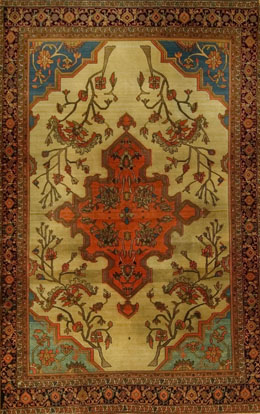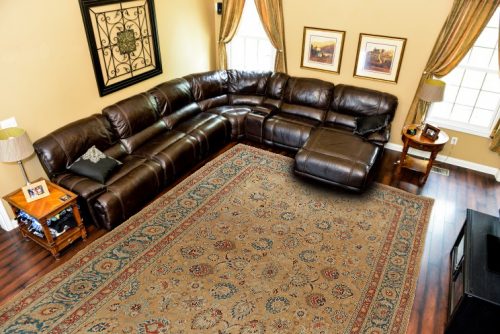Archives: Rug Styles
SAROUK RUGS

EVER POPULAR PERSIAN SAROUK RUGS The vintage rugs of Sarouk, from the Arak province town of that name and surrounding villages, were created to satisfy American demand for a very thick, dense, very long wearing carpet with enough oriental touches to make them instantly identifiable. The wool is amazingly good and the dyes, although in a relatively narrow range, are warm and inviting. The 9’ by 12’ red Sarouk has probably been the most popular rug type ever. It never goes out of style, works with any décor, lasts forever, is not ultra-expensive. What’s not to like?
QASHGAI RUGS

THE FINEST PERSIAN QASHGAI ANTIQUE TRIBAL RUGS The Qashgai are the largest and most influential of the Fars province (SW Iran) nomadic groups. The various subtribes all weave rugs, mostly in scatter sizes. Complex geometric styles are the norm. The best antique rugs of the Qashgai have fine weaves, resilient nomadic wool, crisp drawing and visually arresting saturated colors. Wool foundations are standard. Every design motif gets abstracted by the Qashgai weavers: plants and flowers, animals and birds. Qashgai women are as colorful as their rugs, which are a true folk art They are the best of the Fars tribal
OVERDYE-PATCHWORK RUGS

OVERDYE AND PATCHWORK RUGS These are two recent innovations in the rug world that have become increasingly popular of late. OVERDYE In overdye rugs, these rugs demonstrate a process best described as ‘The modern palette applied to classics’. It consists of an added step to the finishing process in which the rug is antique washed, sheared, and finally hand dyed in a full immersion bath of a chosen color. The effect is quite stunning, adding a vibrant overcast to the whole rug and blending seamlessly with the prior dyes. The carpet now has a single chromatic theme rather than distinct
OUSHAK RUGS
Turkish Oushak Rugs Oushak is a western Turkish town where weavers have been producing striking Oushak Rugs since circa 1400 – 1450 A.D. With such a long history & styles have evolved over and over, and the medallion, star and other Antique Turkish carpet patterns with their saturated tonalities were replaced in the late 19th century by lighter, warmer palettes of unusual colors (pistachio, shrimp, salmon, sky blue, light rust) and designs inspired by, among other sources, Persian allover layouts. The pile is long and lush, the wool soft. Explore our Oushak Rug Collections. Room Size Antique Oushak Rugs-Beautiful &
NAVAJO RUGS

RIGOROUS ABSTRACTION IN NAVAJO RUGS As perpetually fashionable as they are collectible, traditional Navajo rugs, skillfully woven by members of the Native American Navajo tribe, are similar to Kilims and constructed using similar time-honored techniques. The native American Navajo tribe of New Mexico and Arizona was originally weaving wearing blankets in the early 19th century, but when they became settled on the reservation they switched to rugs inspired by Caucasian pieces made available by the local traders. The strong and direct patterns are abstract and geometric, the rigourous color palette usually includes one or more natural sheep tones, and the
NAIN RUGS

IMPOSSIBLY ELEGANT AND BEAUTIFUL NAIN PERSIAN RUGS Nain’s are the ne plus ultra of vintage Persian rugs. Ultra-fine. Ultra-velvety (from Kurk wool). Ultra-expensive. Ultra-Persian in style. Nain is in central Persia and has been weaving top quality pieces since the 1930’s. Five hundred, 600 or even more knots per square inch are common. Any pattern can be created, but the weavers stick mostly to elaborate traditional renditions of medallions, arabesques and palmettes. The color range of any rug is wide and the dyes are perfectly applied. Random variation has no place in the Nain aesthetic. Nain rugs are probably the most
Moroccan Style Rugs
LUSH MODERNIST VINTAGE MOROCCAN STYLE RUGS Exotic, chic, and wonderfully versatile, Moroccan rugs continue to soar in popularity, seducing design aficionados with their patterns and palettes. The mountain dwelling tribes in Morocco have woven increasingly popular, thick pile, highly geometric rugs for the last century. Colors tend to be minimal, natural tones of brown and ivory predominate, and the wool is lusciously long. Vintage Moroccan rugs from the Atlas Mountain tribes with their minimalistic, abstract designs are soooooo decorative and work perfectly with the most modern décor. Twenty years ago, nobody cared for older Moroccan Rugs, now everybody cannot do
MESHAD RUGS

MESHAD RUGS OR MASHAD CARPETS Meshad or Khorassan, the “Province of the Sun” in northeast Persia, has woven interesting rugs since the late 16th century. In the later 19th century high quality room size carpets began to be produced, especially in the Shrine city of Meshed. Emogli and Saber were among the master weavers working there in the 20th century creating carpets the equals of any produced anywhere. Antique rugs and carpets produced in Meshad in the traditional style are notable for several reasons, and are relatively easily identified based on several different characteristics. First, Meshad rugs tend to be
MALAYER RUGS

SUBTLY SUBVERSIVE ANTIQUE PERSIAN MALAYER RUGS Antique rugs from Malayer, east of Hamadan, could be considered top quality Hamadan’s and they share similar structural aspects. Although seemingly urban, virtually every Malayer contains village touches: birds, animals, people or random geometric elements. This makes them playful and unexpected. Some small rugs in medallion patterns and fine weaves mimic Kashan’s or Feraghan Sarouks while larger carpets often employ repeating patterns. THE WOOL IS FINE, THE COLORS ARE PROPERLY AGED The wool is fine, the colors are properly aged and the weaves are good. If an antique Persian rug resembles a Hamadan,
MAHAL RUGS

ELEGANT AND DECORATIVE ANTIQUE MAHAL PERSIAN RUGS Mahal means many things in the rug world. The antique Persian carpets from the British firm of Ziegler with large scale allover patterns in the most desirable soft color’s: rust, ivory, light blue, light green, are Mahal’s. So are the repeating pattern rugs of the 1920’s-30’s with red fields and moderate weaves. The rugs termed Sultanabad’s are Mahal’s. With this chameleon character, there is a Mahal for any space, any décor, and any price point. Mahal’s come from the Mahalat area of western Persia and are almost always in room sizes.(See also Ziegler).







